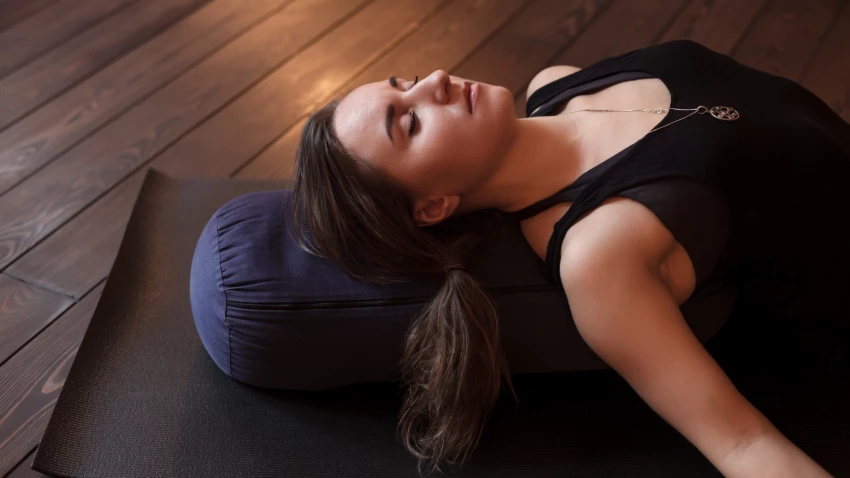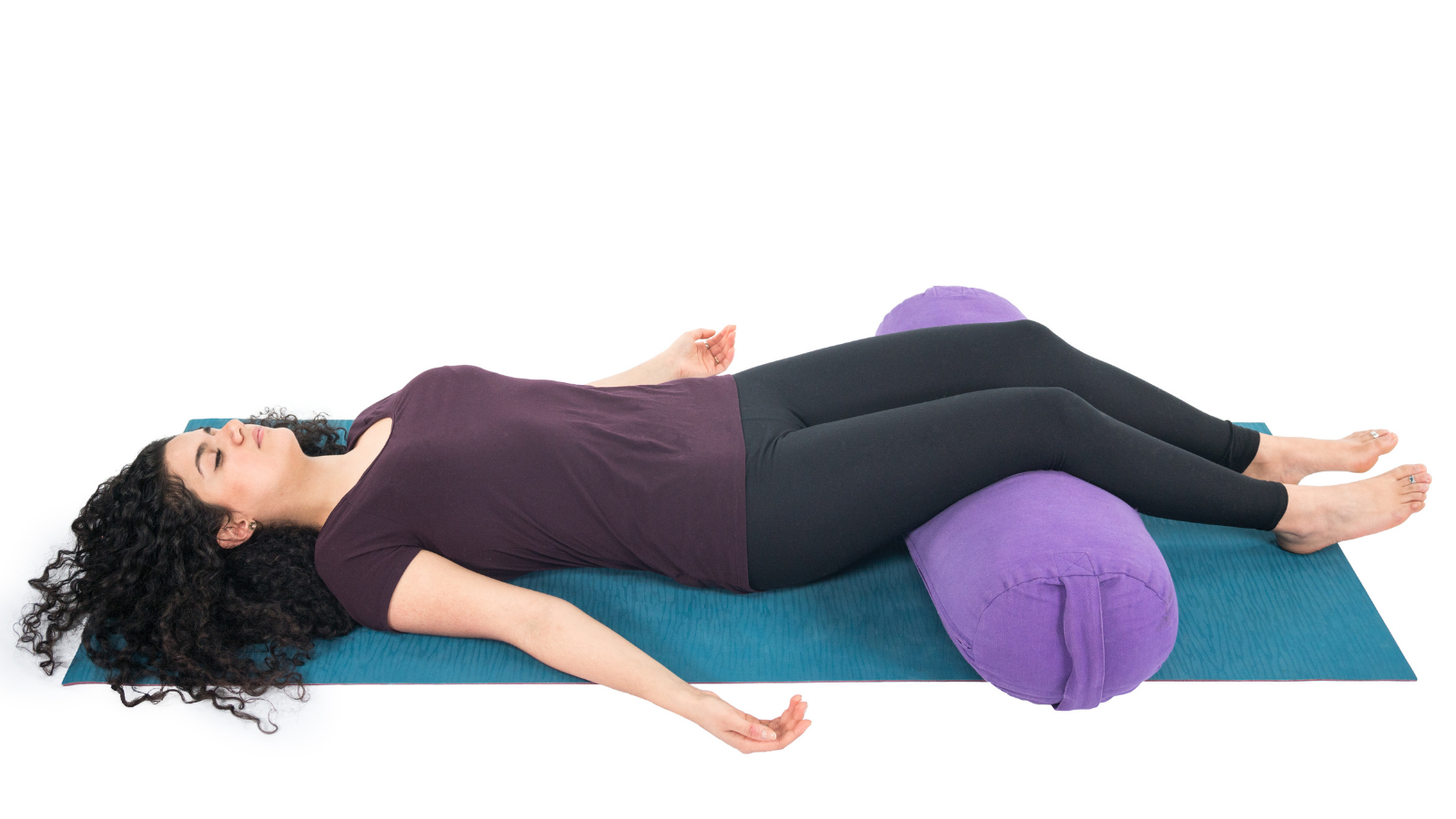6 Steps to a Relaxing Trauma-Informed Savasana

Relaxation Pose (Savasana) is meant to be the highlight of each class—or so I thought when I started practicing yoga. But what if Relaxation Pose brings us more stress than ease? In this article, we explore ways to transform Savasana through a trauma-informed lens.
How Could Savasana be Stressful?
As a new yoga student, I believed after an hour of sweating and flowing through picture-perfect shapes, we are supposed to lie down on our backs, instantly enter a state of deep calm, and wake up at the sound of the teacher’s voice feeling refreshed and spiritually enlightened. But personally, when Savasana was cued, my instinct was always to run away. I assumed my aversion toward Savasana made me a bad yogi and a flawed human being—until I began teaching and observed I wasn’t alone.
There are countless reasons why Savasana may not feel relaxing. Think about it. We are asking our bodies to become defenseless, often in a dark room full of strangers if we practice in a studio setting. Going from our fast-paced, modern lives where we can easily hide behind a screen, to being stretched out, vulnerable, and fully relaxed is a big ask that may not be possible for many, depending on the day.
A Trauma-Informed View of Savasana
If you are human, you’ve likely experienced some form of trauma. Whether the trauma we’ve endured is as extreme as surviving wars, natural disasters, or gender-based violence, or as seemingly trivial as being made to feel small by someone we admired as a child, each experience creates an impression on our bodies and minds. Our unique experiences with trauma may influence our ability to unwind in the context of a yoga class. Therefore, viewing Savasana through a trauma-informed lens can aid teachers who instruct Savasana to a general audience and students who may struggle with this shape. The following trauma-informed suggestions provide a starting point for instructing and practicing a more peaceful Savasana.
How to Practice and Teach Trauma-Informed Savasana

- Ease into Stillness: Jumping from a fast-paced flow to complete stillness in Savasana can be jarring to many. To avoid the sensation of being thrown into cold water, it’s important to ease into stillness by winding class down gradually. Watching the clock to ensure ample time for relaxation can be challenging. This is especially true if sequences are built around a peak pose that requires time, preparation, and instruction to lead into. And yet, what may be more effective than rushing through a peak pose is letting go of expectations to build into a certain shape in favor of creating more time than you think you may need for rest.
- Dim, Not Dark: Are adults also allowed to be afraid of the dark? Absolutely, and there is no shame in that. Being in a pitch-black room can be unsettling to many. Instead of drawing the curtains closed and shutting out all the light, consider dim lighting. You can create this by using a dimmer, keeping a soft glowing lamp or candles lit, or keeping a sliver of a curtain open to allow daylight or moonlight to illuminate the practice space.
- Soft Sounds: Just as darkness can be unsettling, silence can also be hard to warm up to. And yet, some teachers believe music serves as a distraction in Savasana. Instead of playing songs, I often favor chord harmonies or binaural beats—two tones of slightly different frequency in the delta to theta range, which is thought to be linked to deep sleep, relaxation, and meditative states of mind.

- Support the Body: For the nervous system to settle, the body should feel at ease. Lying unsupported on a yoga mat is simply not comfortable for all bodies. This is where props come into play. Either conventional yoga props (e.g., bolsters, straps, blocks, and blankets) or makeshift yoga props (e.g., sweatshirts, cloths, pillows, and towels) can serve in creating comfort. There are many ways to be creative with the placement of props. The following are a few suggestions to explore: 1) a thinly rolled blanket can be placed under the back of the neck for discomfort in the neck or back of the head; 2) cloth can be placed over the eyes for headaches or eye strain; 3) a blanket can be placed over the abdomen for warmth; 4) a pillow or bolster can be used under the knees for low-back discomfort, or 5) a thinly rolled blanket placed under the ankles for any discomfort in the feet or ankle joint.
- Alternative Shapes: Lying on the back may not be the best option physically or emotionally for everyone. Instead of molding ourselves into a specific shape or setting expectations for what Savasana is supposed to look like, we can embrace relaxation in whichever position comes most naturally to us. This may mean lying on the belly, practicing side-lying Savasana, taking legs up the wall, or sitting in meditation in a chair or with the support of a wall.

- Language Matters: Letting go in a group setting requires that we feel accepted and establish trust. Our language is one of the most effective tools in doing so. As we set the stage for Savasana, we can remind students it’s okay to change shapes, to keep a soft gaze rather than keeping the eyes sealed, and to leave the room at any time if needed.
Savasana Transformed
What’s more important than how a yoga pose looks is how it makes us feel. If Savasana hasn’t been comfortable in the past, granting ourselves and our students permission to make the shape our own can transform our experience into one that invites calm, ease, and acceptance at each moment.
Also, read...
Yoga for Stress Relief: 2 Practices for Deep Relaxation
Feb 28 – Beth Gibbs, MA
Nourish Your Winter Body with a Restorative Yoga Practice
Feb 03 – Jillian Pransky
3 Steps to Practicing Active Happiness
Jan 15 – Sandy Blaine
Related courses
Bodymind Ballwork: Myofascial Release for Lifelong Flexibility
With Ellen Saltonstall
Keys to Finding Inner Strength: A Yogic Wisdom Path to Developing Greater Resilience
With Arielle Schwartz
Somatic Yoga for Fascial Unwinding
With James Knight

Lacey Ramirez writes for YogaUOnline and is an ERYT-200 yoga teacher, global health researcher, and writer based in St. Louis. Through her work, she seeks to make yoga accessible, inclusive, and equitable.
Lacey discovered yoga as a tool for centering during her years as a competitive runner. Since then, yoga has served as a way to connect with her body throughout her experience of pregnancy and parenthood. She teaches because she hopes others can use this sacred practice for calming, healing, and transformation.
As a yoga teacher, Lacey specializes in teaching restorative, Yin, prenatal, and trauma-informed Vinyasa yoga. She has also completed birth doula and prenatal/postnatal barre certifications and trainings. Additionally, she holds a Masters of Science in Global Health and Population from Harvard T.H. Chan School of Public Health. To learn more and connect, visit her website laceyramirez.com
Recent articles
3 Myths About Knee Alignment in Yoga
Apr 24 – Jennie Cohen, E-RYT 500, YACEP
4 Great Pigeon Pose Variations
Apr 22 – Leah Sugerman, E-RYT 500, YACEP
Categories
Upcoming courses
Bodymind Ballwork: Myofascial Release for Lifelong Flexibility
With Ellen Saltonstall
Keys to Finding Inner Strength: A Yogic Wisdom Path to Developing Greater Resilience
With Arielle Schwartz
FREE DOWNLOAD!
Recent articles
Almost there...
Sorry, we couldn't find anything...
Anatomy
3 Myths About Knee Alignment in Yoga
You’ve probably heard lots of warnings about how to keep your knees safe in…
Apr 24 – Jennie Cohen, E-RYT 500, YACEP
Yoga Practice Tips
4 Great Pigeon Pose Variations
Which Pigeon Pose variation is for you? Pigeon Pose (Eka Pada Raja Kapotasana) is…
Apr 22 – Leah Sugerman, E-RYT 500, YACEP
Yoga Practice Tips
Dhanurasana (Bow Pose) with a Yoga Strap Bowstring
Years ago, I heard Judith Hanson Lasater pose this question: “Who should practice backbends?”…
Apr 19 –



